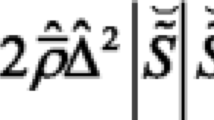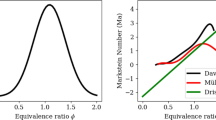Abstract
Detailed-chemistry DNS studies are becoming more common due to the advent of more powerful modern computer architectures, and as a result more realistic flames can be simulated. Such flames involve many alternative fuels such as syngas and blast furnace gas, which are usually composed of many species and of varying proportions. In this study, we evaluate whether some of the commonly used models for the scalar dissipation rate and flame surface density can be used to model such flames in the LES context. A priori assessments are conducted using DNS data of multi-component fuel turbulent premixed flames. These flames offer unique challenges because of their complex structure having many distinct consumption layers for the different fuel components unlike in a single-component fuel. Some of the models tested showed good agreement with the DNS data and thus they can be used for the multi-component fuel combustion.






Similar content being viewed by others
References
Gicquel, L.Y.M., Staffelbach, G., Poinsot, T.: Large eddy simulations of gaseous flames in gas turbine combustion chambers. Prog. En. Combust. Sc. 38, 782–817 (2012)
Veynante, D., Vervisch, L.: Turbulent combustion modelling. Prog. En. Combust. Sc. 28, 193–266 (2002)
Mantel, T., Borghi, R.: A new model of premixed wrinkled flame propagation based on a scalar dissipation equation. Combust. Flame 96, 443–457 (1994)
Borghi, R., Dutoya, D.: On the scales of the fluctuations in turbulent combustion. Proc. Combust. Inst. 17, 235–244 (1979)
Marble, F.E., Broadwell, J.E.: The coherent flame model for turbulent chemical reactions. Tech. Rep. TRW-9-PU Project Squid (1977)
Candel, S.M., Maistret, E., Darabiha, N., Poinsot, T., Veynante, D., Lacas, F.: Experimental and numerical studies of turbulent ducted flames. Marb. Symp., 209–236 (1988)
Pope, S.: The evolution of surfaces in turbulence. Int. J. Engng. Sci. 26, 445–469 (1988)
Bray, K.N.C., Champion, M., Libby, P.A.: The interaction between turbulence and chemistry in premixed turbulent flames. Turbulent Reactive Flows, Lecture notes in engineering, pp. 541-563. Springer Verlag
Bray, K.N.C., Moss, J.B.: A unified statistical model of the premixed turbulent flame. Acta Astron. 4, 291–319 (1977)
Borghi, R.: Turbulent premixed combustion: further discussions on scales of fluctuations. Combust. Flame 80, 304–312 (1990)
Mura, A., Borghi, R.: Towards an extended scalar dissipation equation for turbulent premixed combustion. Combust. Flame 133, 193–196 (2003)
Swaminathan, N., Grout, R.: Interaction of turbulence and scalar fields in premixed flames. Phys. Fluids 18, 045102 (2006)
Kolla, H., Rogerson, J.W., Chakraborty, N., Swaminathan, N.: Scalar dissipation rate modelling and its validation. Combust. Sci. Tech. 181, 518–535 (2009)
Chakraborty, N., Swaminathan, N.: Influence of the Damköhler number on turbulence-scalar interaction in premixed flames I: Physical insight. Phys. Fluids 19, 045103 (2007)
Chakraborty, N., Swaminathan, N.: Influence of the Damköhler number on turbulence-scalar interaction in premixed flames II: Model development. Phys. Fluids 19, 045104 (2007)
Mura, A., Tsuboi, K., Hasegawa, T.: Modelling of the correlation between velocity and reactive scalar gradients in turbulent premixed flames based on DNS data. Combust. Th. Model. 12, 671–698 (2008)
Angelberger, C., Veynante, D., Egolfopoulos, F.: LES of chemical and acoustic forcing of a premixed dump combustor. Flow Turb. Combust. 65, 205–222 (2000)
Charlette, F., Meneveau, C., Veynante, D.: A power-law flame wrinkling model for LES of premixed turbulent combustion Part I: Non-dynamic formulation and initial tests. Combust. Flame 131, 159–180 (2002)
Charlette, F., Meneveau, C., Veynante, D.: A power-law flame wrinkling model for LES of premixed turbulent combustion Part II: Dynamic formulation. Combust. Flame 131, 181–197 (2002)
Fureby, C.: A fractal flame-wrinkling large eddy simulation model for premixed turbulent combustion. Proc. Combust. Inst. 30, 593–601 (2005)
Grinstein, F.F., Fureby, C.: LES studies of the flow in a swirl gas combustor. Proc. Combust. Inst. 2, 1791–1798 (2005)
Wang, G., Boileau, M., Veynante, D.: Implementation of a dynamic thickened flame model for large eddy simulations of turbulent premixed combustion. Combust. Flame 11, 2199–2213 (2011)
Wang, G., Boileau, M., Veynante, D., Truffin, K.: Large eddy simulation of a growing turbulent premixed flame kernel using a dynamic flame surface density model. Combust. Flame 159, 2742–2754 (2012)
Volpiani, P.S., Schmitt, T., Veynante, D.: A posteriori tests of a dynamic thickened flame model for large Eddy simulations of turbulent premixed combustion. Combust. Flame 174, 166–178 (2016)
Mouriaux, S., Colin, O., Veynatne, D.: Adaptation of a dynamic wrinkling model to an engine configuration. Proc. Combust. Inst. 36, 3415–3422 (2017)
Peters, N.: Turbulent Combustion. Cambridge University Press, Cambridge (2000)
Gulder, O., Smallwood, G.J.: Inner cut-off scale of flame surface wrinkling in turbulent premixed flames. Combust. Flame 103, 107–114 (1995)
Knikker, R., Veynante, D., Meneveau, C.: A dynamic flame surface density model for large Eddy simulation of turbulent premixed combustion. Phys. Fluids 16, 91–94 (2005)
Chakraborty, N., Klein, M.: A priori direct numerical simulation assessment of algebraic flame surface density models for turbulent premixed flames in the context of large Eddy simulation. Phys. Fluids 20, 085108 (2008)
Roberts, W.L., Driscoll, J.F., Drake, M.C., Goss, L.P.: Images of the quenching of a flame by a vortex-to quantify regimes of turbulent combustion. Combust. Flame 94, 58–69 (1993)
North, G.L., Santavicca, D.A.: The fractal nature of turbulent premixed flames. Combust. Sc. Techn. 72, 215–232 (1990)
Kerstein, A.: Fractal dimension of turbulent premixed flames. Comb. Sc. Techn. 60, 441–445 (1988)
Katragadda, M., Chakraborty, N., Cant, R.S.: Effects of turbulent Reynolds number on the performance of algebraic flame surface density models for large Eddy simulation in the thin reaction zones regime: A direct numerical simulation analysis. J. Comb., 794671 (2012)
Dunstan, T., Minamoto, Y., Swaminathan, N., Chakraborty, N.: Scalar dissipation rate modelling for large Eddy simulation of turbulent premixed flames. Proc. Combust. Inst. 34, 1193–1201 (2013)
Gao, Y., Chakraborty, N., Swaminathan, N.: Algebraic closure of scalar dissipation rate for large eddy simulations of turbulent premixed combustion. Comb. Sc. Tech. 186, 1309–1337 (2014)
Kolla, H., Rogerson, J.W., Chakraborty, N., Swaminathan, N.: Scalar dissipation rate modelling and its validation. Combust. Sci. Technol. 181, 518–535 (2009)
Girimaji, S., Zhou, Y.: Analysis and modelling of sub-grid scalar mixing using numerical data. Phys. Fluids 8, 1224 (1996)
Gao, Y., Chakraborty, N., Swaminathan, N.: Dynamic closure of scalar dissipation rate for large eddy simulations of turbulent premixed combustion: A direct numerical simulation analysis. Flow Turb. Combust. 95, 775–802 (2015)
Langella, I., Swaminathan, N., Gao, Y., Chakraborty, N.: Assessment of dynamic closure for premixed combustion large Eddy simulation. Combust. Th. Model. 19, 628–656 (2015)
Langella, I., Swaminathan, N.: Unstrained and strained flamelets for LES of premixed combustion. Combust. Th. Model. 20, 410–440 (2016)
Langella, I., Swaminathan, N., Pitz, R.W.: Application of unstrained flamelet SGS closure for multi-regime premixed combustion. Combust. Flame. 173, 161–178 (2016)
Gao, Y., Minamoto, Y., Tanahashi, M., Chakraborty, N.: A priori assessment of scalar dissipation rate closure for large Eddy simulations of turbulent premixed combustion using a detailed chemistry direct numerical simulation database. Combust. Sc. Tech. 188, 1398–1423 (2016)
Minamoto, Y., Fukushima, N., Tanahashi, M., Miyauchi, T., Dunstan, T., Swaminathan, N.: Effect of flow-geometry on turbulence scalar interaction in premixed flames. Phys. Fluids 23, 125107 (2011)
Das, A.K., Kumar, K., Sung, C.: Laminar flame speeds of moist syngas mixtures. Combust. Flame 158, 345–353 (2011)
Nikolaou, Z.M., Chen, J.Y., Swaminathan, N.: A 5-step reduced mechanism for combus- tion of CO/H2/H2O/CH4/CO2 mixtures with low hydrogen/methane and high H2O content. Combust. Flame 160, 56–75 (2013)
Singh, D., Takayuki, N., Saad, T., Qiao, L.: An experimental and kinetic study of syngas/air combustion at elevated temperatures and the effect of water addition. Fuel 94, 448–456 (2012)
Nikolaou, Z.M., Swaminathan, N.: Direct numerical simulation of complex fuel combustion with detailed chemistry: Physical insight and mean reaction rate modelling. Comb. Sc. Tech. 187, 1759–1789 (2015)
Cant, R.S.: SENGA2 User Guide, CUED/A–THERMO/TR67 September (2012)
Nikolaou, Z.M., Swaminathan, N.: Evaluation of a reduced mechanism for turbulent premixed combustion. Combust. Flame 161, 3085–3099 (2014)
Nikolaou, Z., Swaminathan, N.: A 5-step reduced mechanism for combustion of CO/H2/H2O/CH4/CO2 mixtures with low hydrogen/methane and high H 2O content. Comb. Flame 160, 56–75 (2013)
Peters, N.: The turbulent burning velocity for large-scale and small-scale turbulence. J. Fluid Mech. 384, 107–132 (1999)
Nikolaou, Z., Swaminathan, N.: Heat release rate markers for premixed combustion. Comb. Flame 161, 3073–3084 (2014)
Chatakonda, O., Hawkes, E.R., Aspden, A.J., Kerstein, A.R., Kolla, H., Chen, J.H.: On the fractal characteristics of low Damkohler number flames. Combust. Flame 120, 2422–2443 (2013)
Butz, D., Gao, Y., Kempf, A.M., Chakraborty, N.: Large Eddy simulations of a turbulent premixed swirl flame using an algebraic scalar dissipation rate closure. Combust. Flame 162, 3180–3196 (2015)
Cant, R.S., Pope, S.B., Bray, K.N.C.: Modelling of flamelet surface to volume ratio in turbulent premixed combustion. Proc. Combust. Inst. 23, 809–815 (1990)
Hawkes, E.R., Cant, R.S.: A flame surface density approach to large eddy simulation of premixed turbulent combustion. Proc. Combust. Inst. 28, 51–58 (2000)
Hawkes, E.R., Cant, R.S.: Implications of a flame surface density approach to large eddy simulation of premixed turbulent combustion. Combust. Flame 126, 1617–1629 (2001)
Chakraborty, N., Cant, R.S.: Direct numerical simulation analysis of the flame surface density transport equation in the context of large Eddy simulation. Proc. Combust. Inst. 32, 1445–1453 (2009)
Acknowledgements
ZMN and NS acknowledge the funding through the Low Carbon Energy University Alliance Programme supported by Tsinghua University, China. ZMN also likes to acknowledge the educational grant through the A.G. Leventis Foundation. This work made use of the facilities of HECToR, the UK’s national high-performance computing service, which is provided by UoE HPCx Ltd at the University of Edinburgh, Cray Inc and NAG Ltd, and funded by the Office of Science and Technology through EPSRC’s High End Computing Programme. ZMN also acknowledges PRACE for awarding us access to resource Beskow of PDC center for high-performance computing based in Sweden at KTH.
Author information
Authors and Affiliations
Corresponding author
Ethics declarations
Conflict of interests
The authors declare that they have no conflict of interest.
Additional information
Publisher’s Note
Springer Nature remains neutral with regard to jurisdictional claims in published maps and institutional affiliations.
Rights and permissions
About this article
Cite this article
Nikolaou, Z.M., Swaminathan, N. Assessment of FSD and SDR Closures for Turbulent Flames of Alternative Fuels. Flow Turbulence Combust 101, 759–774 (2018). https://doi.org/10.1007/s10494-018-9903-9
Received:
Accepted:
Published:
Issue Date:
DOI: https://doi.org/10.1007/s10494-018-9903-9




